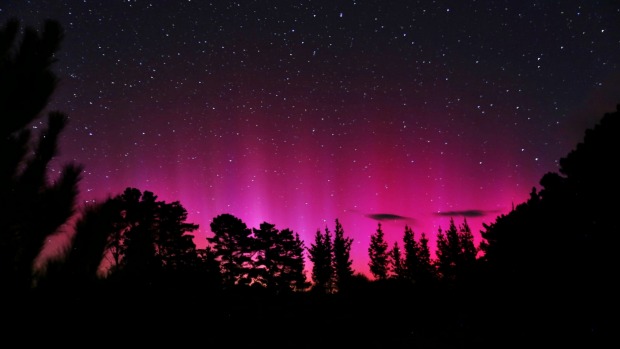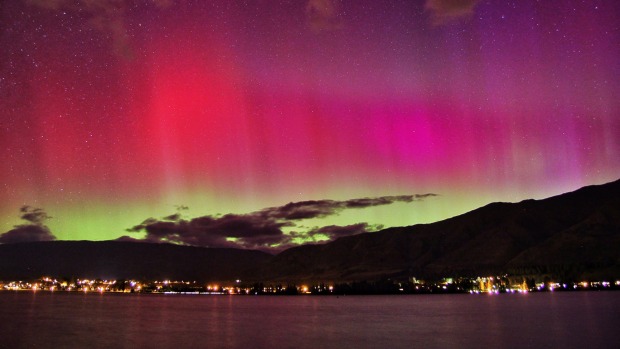
The storm, which began on Tuesday, is among the strongest in the current 11-year solar cycle, earning a rating of a "severe" G4 on a one-to-five scale, which means it had the potential to affect power grids, high-frequency communications and satellite operations.
Interestingly, there was no radiation storm, which typically accompanies geomagnetic storms of this magnitude. Therefore, NOAA's Space Weather Prediction Center was not expecting disruption to satellite electronics or polar-routed aviation.
But the changes in density in the ionosphere - the very high levels of Earth's atmosphere - could cause more drag on low-orbit satellites, which operators may have to adjust for with thrusters. Simple GPS technology, like the kind in your car or on your smartphone, could be affected in the form of difficulties locating your position.
The solar wind was not particularly fast, but it was potent enough to cause the severe geomagnetic storm, according to Joe Kunches, director of space weather services at Atmospheric and Space Technology Associates.
Quick & Dirty all sky timelapse of last night's Aurora Australis over Dunedin. https://t.co/grEmccCUTt #Dunedin #aurora
— Ian Griffin (@iangriffin) March 17, 2015
Happy Saint Patrick's Day! Green from space. We have @Space_Station aurora views: [video] https://t.co/UG1x2YutsO pic.twitter.com/FBpXJ5OIhd
— NASA (@NASA) March 17, 2015
Rendering 300 frames takes a while doesn't it! Meanwhile, here's another still from last night. #Dunedin #aurora pic.twitter.com/KWqHLnrEjA
— Ian Griffin (@iangriffin) March 17, 2015
There's a stunning aurora over Crowborough, East Sussex tonight. The view from the Wetherspoons car park is magical. pic.twitter.com/nLfMzMGqNg
— Nick Harvey (@mrnickharvey) March 17, 2015
Solar storm smacks Earth, pushes northern lights — so more people can enjoy colorful sky show http://t.co/7ESH5nGvHD pic.twitter.com/Dvi3SZtwLBThe storm's strength came as somewhat of a surprise to forecasters and was probably caused by the combination of two coronal mass ejections from an active sunspot region, forecasters at the prediction centre said.
— CBS News (@CBSNews) March 17, 2015
Space weather models predicted just a "glancing blow" from these ejections, which instead have caused a stronger disruption here on Earth, and vivid auroras.
Sunspots full of high magnetic energy frequently explode and send plumes of radiation called solar flares into space. When these flares and the super-heated plasma that can accompany them interact with Earth's magnetic field, radioactive energy sometimes makes it into the Earth's upper atmosphere.
These particles can interfere with radio communications and global positioning systems, and when strong enough, they can even harm the electrical grid. But they do have at least one positive effect: The impact of the particles with the upper atmosphere creates a beautiful glow that we know as the northern lights.
Because the Earth's magnetic field funnels charged particles from these solar storms towards its poles, polar regions are much more likely to be affected by them. That's why the auroras are most frequently seen at the poles and rarely make it to North America, as they have this week.
Solar cycles are periodic changes in the sun's activity, including the number of sunspots and solar flares, that have an average duration of about 11 years. They are marked by solar maximums and minimums. The sun is currently close to the solar maximum of this cycle, which began on January 4, 2008, and likely peaked in April 2014.
The Space Weather Prediction Center, part of the National Oceanic and Atmospheric Administration, ranks the intensity of geomagnetic storms on a G-scale of one to five, with five being the strongest. According to the centre, on average around 100 G4-magnitude storms occur every solar cycle. This is the first G4 storm since the fall of 2013. There hasn't been a G5 storm - the strongest on the scale - since August 2005.
The current storm is in season, so to speak, since they are most common around the equinoxes.
Research as to why solar storms are more common and severe around the equinoxes is still ongoing, but it most likely has to do with the way the Earth's position relative to the sun changes. The Earth's orientation changes what parts of its magnetic field are interacting with the sun's, making those interactions more volatile.
North Island Aurora
Central North Island residents were seeing pink as the Southern Lights, or Aurora Australis, lit up the sky.
The Aurora Australis is usually only visible in southern New Zealand but was clear in the skies over Himatangi Beach in the Manawatu when resident Steve Chadwick snapped some pictures before midnight.
Chadwick, who teaches astronomy and philosophy at Massey University and dabbles in astrophotography, said he was out taking pictures from about 9pm.
"You need a dark sky away from the city lights and you have to be able to have a long exposure," he said.
"At this latitude they're a lot fainter than in the pictures but at best you could see faint red."
As someone who's lived in the Manawatu for most of his life, this was only the second time he'd ever seen the lights so it was a special moment, he said.
Travel blogger Liz Carlson captured the stunning sky from Wanaka. "Last night you could see beams of light dancing over the mountains around Wanaka and you had every colour visible, red, yellow, pink purple and green. It was pretty spectacular to see. This was shot with a 15 second exposure from Eely Point looking over Lake Wanaka around 11pm."
Palmerston North Astronomical Society president Jeremy Moss said the colourful light phenomena was caused by charged particles, like protons, neutrons, ions and electrons, being released from the sun and hitting the Earth's atmosphere.
"The closer you are to the pole, so north and south, the more likely you are to see it," he said.
"We don't see it very often in the north of New Zealand unless there's some pretty serious solar activity going on so we were pretty lucky last night."
He said the lights were reasonably common in Southland and they usually didn't last for more than several minutes.




Reader Comments
to our Newsletter